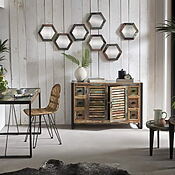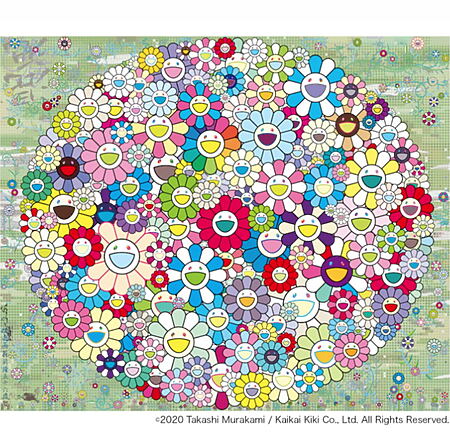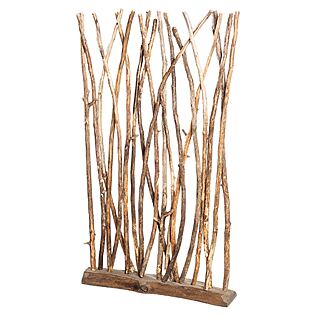Wand carpets have an impressive story that goes back to ancient Egypt, where it already served as precious grave goods. During the Renaissance in Europe, they were particularly valued and were considered the clear sign of a high social status. Today these textile works of art a remarkable renaissance in the modern facility.
Modern wall carpets are characterized by light fabrics, geometric patterns and abstract motifs , which gives them a contemporary ease. They also offer practical advantages: they dampen noises and significantly improve space acoustics. The variety of available materials - from traditional wool to natural fibers to art fibers and silk - enables a wide range of designs and textures. Macrame wall carpets are currently particularly popular , which come from oriental link techniques and fit perfectly with the boho style.
This style guide shows beginners on how to hang up tapestries, what to buy from the wall carpets and how different styles from classic tapestry to ethnic patterns can enrich rooms in completely different furnishing styles .
A short story of the wall carpets
The earliest traces of mandrel carpet art lead back to ancient Egypt , where they served as grave goods and, thanks to the dry desert climate, have been preserved for thousands of years. The oldest discovered carpet is called "Pacyryk" and was found in 1949 by Professor Rudenko in the remote Altai Mountains-perfectly preserved in the eternal ice cream of southern Siberia. However, indications indicate that the origin of linked carpets is still a few thousands of years ago.
From Egypt to Europe: a journey through the centuries
Already in the 3rd century BC, Alexander brought the great Persian carpet to Europe. Later, other copies of long -distance travelers such as Marco Polo , who reported in 1283 about the extraordinary beauty and quality of the carpets from Konya.
In the Middle Ages, cross knights also brought oriental carpets to Europe. Under the influence of Moorish culture, the 8th/9th Century on the Iberian Peninsula the first European carpet center.
Tobelin and image active: The art of the woven picture
the image active is one of the oldest craftsmanship of mankind. In contrast to classic weaving mill, the colored shot threads are only back and forth in the edge of the specified color surface, not through the entire width. The famous Gobelin Manufaktur in Paris was founded in 1607 and raised the royal tapisserie manufactory . Under Louis XIV, she employed about 250 tapissiers and 50 apprentices.
Their flowering experienced the image active in the Middle Ages and in the Renaissance. One of the oldest Western European visual carpets is the Abraham-Engel Tipest (around 1150), which is kept in the Halberstadt cathedral treasure. The visual carpets at the Burgundian Herzoghof in the 15th century were particularly impressive, where Duke Philipp of the good even had a fire -proof vault built for their storage.
Wall carpets as a status symbol and heat donor
In their early days, wall carpets fulfilled numerous practical functions - they served as a tent, bed, chair, table and even as a container in the form of saddle pockets. They also offered effective thermal insulation in cold stone buildings and significantly improved the room acoustics .
For a long time, they were reserved for the rich as status symbols Rulers like the Persian Shah Abbas promoted the handicrafts by founding court manufacturers. On ceremonial occasions, precious visual carpets decorated frame or even entire places - a clear sign of wealth and power. Prince and kings gave away precious tapestries to emperors and popes to gain political support.
Modern wall carpets and their styles
In contemporary interior design, tapestries experience a remarkable change. Unlike their historical predecessors, modern wall carpets are characterized by diverse styles that can give each room a personal touch.
Geometric patterns and abstract designs
Modern wall carpets with geometric shapes and abstract designs have become particularly popular. The clear lines, triangles and circles in high -contrast colors give rooms a structured look and set strong accents. This design direction is in the tradition of the Bauhaus, where cubist breakdown and geometric forms were already characteristic of textile designs in the 1920s.
While previously large -format geometric shapes dominated, the designs are now developing into increasingly delicate designs and sometimes also curved lines.
Boho, Ethno and Scandinavian influences
The boho style with its hand-woven carpets made of natural materials and living patterns gives rooms a dreamy flair. Ethnic patterns from different cultures bring warmth and depth into the living environment. In contrast, tapestries in Scandinavian style characterized by simplicity and functionality.
You often use a reserved color palette with neutral tones such as white, gray and beige and gentle pastel colors. The patterns are usually simple and geometric - stripes, diamonds or zigzag lines that radiate elegance and calm.
Macrame as a modern alternative
Macrame is currently particularly trendy-a knotting art from the Orient that fits perfectly with the trendy boho style. This traditional technology has been experiencing a remarkable revival for several years. Macrame wall proposals immediately create cosiness and are the creative-dreaming alternative to pictures.
From the classic beige or white, modern macrame works of art develop into colorful, shaped objects-from rainbows to leaf shapes.
Materials: from wool to silk
In modern wall carpets, the selection of materials plays a crucial role. Natural fibers such as wool, cotton or jute dominate in boho and Scandinavian style. Natural silk or bamboo silk are used for particularly high -quality pieces

The use of different yarns and bindings creates beautiful accents and height variations wall carpet "Dreamy Woman" Some details are often emphasized by embroidered parts or by incorporating gloss and lurex yarns into the tissue itself.
Tencel (also known as Lyocell), obtained from the eucalyptus plant, is a newer sustainable alternative that gives an elegant and modern expression due to its slightly shiny property. The conscious choice of natural and sustainable materials corresponds to the current trend towards more mindful consumption.
Use the wall carpets correctly in the home
The strategic placement of wall carpets turns every room into a personal oasis of wellbeing. Unlike pictures or photos, these textile works of art not only bring color and pattern, but also valuable acoustic properties to every living area.
Living room: Statement Pieces and Structure
The living room is particularly suitable for impressive statement carpets that immediately catch the eye. A striking wall carpet with living patterns can serve as a central eye -catcher above the sofa. Geometric patterns ensure a modern look and set strong accents. When placement, the carpet should be well lit to emphasize details.
In addition, tapestries can structure open living spaces and optically separate different areas. This zoning gain extensive rooms. When choosing the material, you should pay attention to high -quality fabrics such as cotton or linen that give the room depth and character.
Bedroom: warmth and calm through textiles
In the bedroom, tapestries create a warm, cozy atmosphere and contribute to sound insulation . They are particularly effective behind the bed, where they not only serve as a headgear alternative, but also improve space acoustics. Natural materials such as wool or cotton create a particularly pleasant feel and ensure a calming effect.
A wall carpet with natural textures or gentle floral patterns underlines the calm and elegance of the bedroom. The colors of the carpet should be harmoniously coordinated with the rest of the device.
The hallway and entrance area: design the first impressions
The entrance area is the business card of the home. A wall carpet can not only create an inviting first impression, but also offer practical advantages. When choosing a size, the following applies: The carpet should be about 60 cm shorter than the smallest wall in the hallway so that doors can be opened without any problems.
Elongated carpets or classic runners are suitable in narrow corridors, while in larger entrance areas there are also round carpets. For this heavily frequented area, robust, easy -care materials and possibly patterned designs are recommended, on which stains do not immediately become visible.
Children's and youth rooms: use colors and patterns creatively
Wand carpets can be particularly colorful and playful in the children's room. Colorful animal motifs or educational designs such as world maps awaken the imagination and at the same time offer learning opportunities. Modern wall carpets in the children's room ensure a warm and cozy atmosphere and frame the room in a soft way.
In addition, they contribute to soundproofing - particularly important in a room where playing and romping. In addition to the design, the selection should also be paid to easy -to -clean materials, since children's rooms are exposed to special stresses.
Tips for hanging, maintaining and buying
In the practical handling of tapestries, several factors play a decisive role for long -lasting joy in these textile works of art. From the right hanging to regular care, there are some important aspects to consider.
Hang up the wall carpets: weight and fastening
The weight of the wall carpet significantly determines the optimal fastening method. Light and small -format carpets are easier to attach than heavy, densely woven specimens. Various methods are available for assembly:
- Velcro tape is ideal for light to moderate carpets and leaves no wall damage
- Nail strips offer more stability for heavier pieces and distribute the weight evenly
- Curtains combined with sewn -on loops made of tear -resistant fabric create a classic look
When hanging up, the carpet should be about 5-10 cm away from the wall on all sides so that it does not look too bulky. In addition, the help of a second person is recommended for larger pieces to evenly attach the carpet.
Easy -care materials and cleaning
Regular care is essential so that the wall carpet remains handsome for a long time. The carpet should be sucked off every two days to prevent dirt from stuck. In the case of short flare carpets, an attachment with a brush is recommended, while long -fleece carpets are better cleaned without cleaning.
Materials such as polypropylene and polyester are particularly easy to care for and hard -wearing. Wool offers natural dirt protection through its natural fats and is stretchy up to 30%. Cotton, in turn, has a thermore -regulating effect and is well suited for allergy sufferers.
Buy wall carpets: what to look for?
When buying a wall carpet, the weight should first be taken into account. Light, flat -woven carpets or short flare carpets are better suited for hanging than heavy wool carpets. For rooms with pets, flat -woven carpets made of synthetic fibers are recommended so that no animal hair gets caught.
In addition, the manufacturer's care instructions should be observed. Sisal and jute fibers have an antistatic effect and do not attract a dust. Viskose is quite uncomplicated with care.
DIY or ready to buy: what fits better?
A homemade wall carpet has several advantages: it is guaranteed to be unique, fits your own style exactly and is significantly cheaper than handmade purchase copies. The DIY project also offers a high relaxation factor and brings joy when you hold the finished work in your hands.
Nevertheless, for some living situations, a finished carpet can be the promising choice - especially if special materials or elaborate web techniques are desired that require special skills.
Wall carpets have their fixed place in modern living space design
Wand carpets undoubtedly found their permanent place in the modern facility. The centuries -old tradition of these textile works of art connects today with contemporary designs and diverse styles. The development of heavy tapestry to a slight macrame wall hung, which gives each room a personal touch, seems particularly remarkable. Although used to be mainly used as a status symbol and heat dispenser, tapestries now primarily serve as aesthetic elements with practical advantages for room acoustics.
The correct placement of a wall carpet depends largely on the room concept. While large-format statement areas often dominate in the living room, textiles in the bedroom create a calming atmosphere. The entrance area, on the other hand, benefits from an inviting wall carpet, which at the same time acts as a business card of the home. Children are also happy about colorful motifs that stimulate their imagination.
The material plays a crucial role in choosing a suitable wall carpet. Natural fibers such as wool and cotton not only offer pleasant feel, but also good care properties. Alternatively, art fibers stand for special durability. Regardless of the selected material, however, attention should be paid to the weight so that the fastening is easy.
Ultimately, the following applies: The joy of a wall carpet grows with the right care. Regular suction prevents the accumulation of dust, while the appropriate cleaning method varies depending on the material. If you take these essential tips to heart, you will enjoy your textile wall decorations for a long time and at the same time benefit from its spatial acoustic properties.

Owner and Managing Director of Kunstplaza. Publicist, editor, and passionate blogger in the field of art, design, and creativity since 2011. Successful completion of a degree in web design as part of a university program (2008). Further development of creativity techniques through courses in free drawing, expressive painting, and theater/acting. Profound knowledge of the art market through many years of journalistic research and numerous collaborations with actors/institutions from art and culture.

















